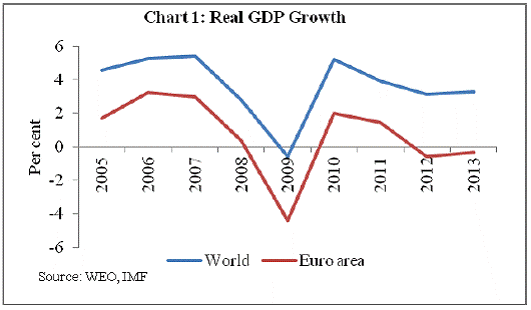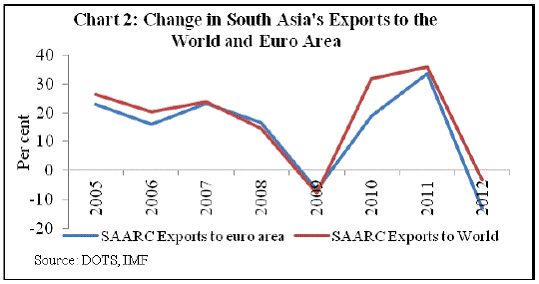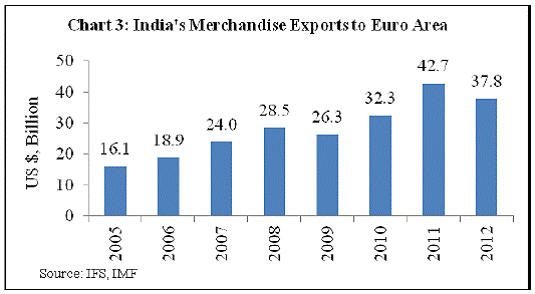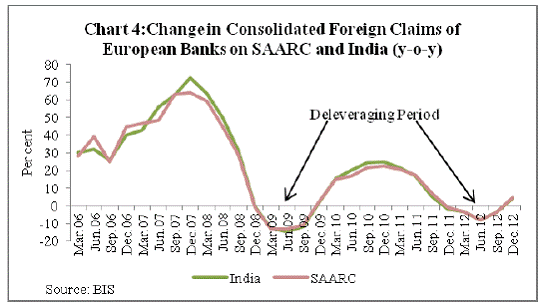 IST,
IST,


Impact of Euro Area Crisis on South Asia
Shri Deepak Mohanty, Executive Director, Reserve Bank of India
delivered-on జూన్ 18, 2013
The global financial crisis originated in the US and then spread to Europe. While the global growth has recovered from the trough of 2009, Europe has lapsed into recession again. The continuing uncertainty in the euro area poses a major risk to the global economy today. It has affected the growth prospects of both advanced and emerging market economies through trade, financial and confidence channels. Given the interconnectedness of global financial markets, the principal risk to emerging markets and developing countries (EMDEs) arise from ‘risk on’ and ‘risk off’ behaviour of global financial market. Of late through following resolute policy actions, financial conditions have improved in the euro area (IMF, 2013)1. However, the real economy has shown no sign of improvement. With very little fiscal space, macro policy response to growth slowdown remains limited. The euro area crisis first surfaced in 2009 when Portugal, Ireland, Greece and Spain slipped into recession with exceedingly high budget deficits. The crisis deepened further in 2010 with credit rating agencies downgrading the sovereigns and banks in the peripheral Europe. This significantly dented confidence, even threatening the very existence of the euro. Consequently, the risks to the global economy rose. Against this backdrop, I briefly touch upon the causes of crisis and subsequent stability enhancing policy measures in euro area. I then turn to how the crisis affected South Asia, particularly India. I conclude by highlighting some mitigating measures that we have taken to strengthen our external account. Causes of the Crisis The problems in the euro area are largely structural in nature and existed even prior to the crisis. The global crisis only amplified the weaknesses in the system. “In the years preceding the crisis, the EU became divided between countries with positive trade balances and sound budgets – the core - and those with growing budget deficits and external deficits financed by private credit flows increasingly sourced from the first group of countries for unproductive spending – the periphery. With the onset of global financial crisis, the external deficits, budget deficits and levels of public debt of the countries in the second group largely became unsustainable once they were no longer financed by the rest of the EU (Draghi, 2013)2”. The origin of the euro area crisis is in the high level of fiscal deficit and debt. First, a large part of the fragile fiscal position in these economies is attributable to expenditure on entitlements due to an ageing population without commensurate increase in revenues and lack of growth- enhancing structural reforms. In this process, the public sector structure has become bloated. Second, due to low domestic saving rate, public debt had to be financed through borrowings resulting in widening of current account deficit and a growing external debt. While the membership of the euro area gave a false sense of comfort to the periphery countries, the intra-euro area financial imbalance remained severe. Third, as the euro area crisis unraveled, the interconnection between sovereigns and banks was reflected in the positive correlations between sovereign and bank credit default swap (CDS) spreads especially for the periphery countries. The management of the euro area crisis has become complex because of three reasons. First, consequent to rating downgrades, a number of countries have faced rising bond yields and challenges in funding the sovereign debt. Second, euro area banks are undercapitalized, mainly due to losses on sovereign bonds, and have faced liquidity problems leading to credit constraints. Third, slow/negative economic growth accentuated fiscal risks (Chart 1). Let me now turn to policy measures taken to stabilize the euro area. Policy Measures The crisis has prompted the European Union (EU), the European Central Bank (ECB) and the International Monetary Fund (IMF) to take several measures to stabilize the European economies. The creation of the European Financial Stability Facility (EFSF) in 2010 and the European Financial Stability Mechanism (EFSM) in 2011 responded to the urgency of crisis in the periphery. However, many subsequent improvements that led to the establishment of the European Stability Mechanism (ESM) have placed the regional financing arrangements on a much stronger footing. In addition, the EU is also addressing the institutional deficiencies in the monetary union by gradually moving towards banking and the fiscal union. Europe took its first big step towards banking union in December 2012, as EU finance ministers agreed to make the ECB the common bank supervisor. The EU has also tried to make fiscal rules more stringent. In this regard, the treaty on stability, coordination and governance known as “fiscal compact”, has come into force in January 2013. This is an intergovernmental Treaty which establishes that member states must enact laws, preferably at constitutional level, requiring their national budgets to be in balance or in surplus within the Treaty's definition. The laws must also contain a self-correcting mechanism to prevent any breach. The Treaty defines a balanced budget as a general budget deficit of less than 3.0 per cent of GDP, and a structural deficit of less than 1.0 per cent of GDP if the debt level is below 60 per cent. If the debt level is above 60 per cent of GDP, the structural deficit norm is more stringent at below 0.5 per cent of GDP. The “two-pack” regulations subject euro area countries to the obligation of ex ante notification of budgetary plans to the European Commission (EC). Should countries be subject to an excessive deficit procedure (EDP) or be involved in a financial assistance program by the ESM, they will also be subject to an enhanced monitoring by the EC (Praet, 2013)3. The ECB has taken a number of policy measures ranging from lowering the policy interest rate, substantial bond buying and provision of concessional loans to banks. The ECB launched its Long Term Refinancing Operations(LTRO) which made available three-year loans to banks: 523 banks borrowed €489 billion in December 2011 and 800 banks borrowed € 530 billion in February 2012. The ECB launched Outright Monetary Transactions (OMT) in September 2012 to make discretionary purchases of short-term sovereign bonds with a prior request by the concerned sovereigns for international assistance via the EFSF/ESM. The IMF contributed to emergency lending and has elaborated and monitored the economic adjustments programs for Greece, Ireland and Portugal in close cooperation with the EC and the ECB known as the ‘Troika’. Even though the major share of the financial support has come from euro-zone countries, the scale of the IMF’s lending has been substantial. Since the size of the rescue packages has been huge, the cooperation with the EC and ECB was important as IMF alone would not have been able to raise the entire quantum of emergency funds. Let me now turn to the impact of the euro area crisis on SAARC region. Impact on South Asia The euro area has traditionally been an important economic partner for South Asia. The share of exports to the euro area in total exports ranged from around 38 per cent for Maldives to 10 per cent for Nepal with India’s share being 13 per cent in 2012. Between 2011 and 2012, share of SAARC’s export to euro area has contracted significantly (Table 1). In addition to absorbing a significant share of the region’s exports, it has been a source of foreign direct investment and other forms of capital flows (Lee et al. 2013)4. It is interesting to note that when the euro area crisis hit the global economy in 2010, our exports to that region did not decline immediately. This was mainly because of our two major trading partners, viz., Germany and France, which were doing well. In the subsequent period, as the crisis intensified, our exports to euro area declined (Chart 2). Another way in which euro area crisis has impacted the South Asian economies is through the finance channel. European banks have been an important source of credit to South Asia. According to the Bank for International Settlements (BIS), at the end of December 2012 consolidated claims of the European banks on South Asia amounted to around US $164 billion, equivalent to 44 per cent of the region’s total foreign banks’ claims. There has also been an impact through the stock markets. While deleveraging by European banks reduced lending to emerging markets, shifting of investor sentiment reduced flow to emerging stock markets (Avdjiev et al. 2012)5. Let me now turn to the impact on India Impact on India Indian economy is significantly integrated with the euro area. The impact so far has been mainly through trade and finance channels. As a result of slowdown in euro area, the India’s merchandise exports to the region declined from US$ 42.7 billion in 2011 to US$ 37.8 billion in 2012 (Chart 3). Consequently, its share in India’s total exports declined from 13.9 per cent to 12.8 per cent. In fact, euro area’s share in India’s exports was much higher at 16 per cent in 2008 (Table 1). Furthermore, the share of India’s software services exports to Europe declined from 26 per cent of total software export earnings in 2009-10 to 24 per cent in 2011-12. Europe accounts for more than one-third of total tourist arrivals in India. Travel receipts have also suffered because of lower tourist arrivals from the euro area, particularly from the affected countries. Deleveraging in European banking system impacted credit flows to India (Chart 4). The consolidated claims of the European banks on India declined from US$ 146 billion in December 2010 to US $ 139 billion in December 20126. Euro area is also an important source of foreign direct investment (FDI) to India. It accounted for around 18 per cent of the total FDI into India in 2012-13. Given the more stable nature of these flows as compared to foreign institutional investment (FII) flows, the crisis has had a marginal impact on the FDI flows to India. When the crisis began, the FDI flows from euro area economies declined from about US$ 3.5 billion in 2009-10 to about US$ 3.1 billion in 2010-11. However, it recovered to US$ 4.2 billion in 2011-12 and around US$ 3.5 billion in 2012-13 (Table 2). In addition, Europe constitutes a major source of private transfer inflows to India, around 19 per cent in 2008-09. As the unemployment situation in euro area continues to deteriorate, it may have an adverse impact on remittance flow to India. Conclusion The uncertainty about the duration of the euro area crisis persists as there has not been much improvement in its real economy despite a string of policy steps. While reforms are being initiated, fresh concerns are surfacing: for example, recent downgrade of both Italy and France. In India, we have been proactive in addressing the challenges posed by the uncertainties in the global economy, particularly in the euro area. As capital inflows to our economy have turned volatile, financing of our large current account deficit has become a challenge. In this context, various policy measures have been undertaken by the Reserve Bank and the Government to moderate imports and to improve capital inflows. Oil and gold are the two major items of our imports. With regard to oil, the domestic pricing has increasingly been made market determined. It is expected that this will help economizing the domestic oil consumption. Recently import duty on gold has been raised and bank finance against pledge of gold has been restricted. The efficacy of these measures, however, is yet to be tested. We have also introduced inflation indexed bonds which should help contain gold demand to the extent these bonds are used as an investment hedge against inflation. Notwithstanding these measures for a fast growing economy like ours, import demand is bound to be high. Hence, we have to step up exports to narrow the trade gap. But in a phase of sluggish global economy, it is difficult to push up exports. Nevertheless, initiatives have been taken to diversify trade towards emerging markets. On balance, however, the current account deficit remains high thus needs to be financed through capital inflows. The policy measures taken to encourage capital inflows include liberalisation of the interest rates on non-resident deposits and external commercial borrowings, rationalisation of norms related to foreign institutional investment (FII) in infrastructure debt and allowing foreign direct investment (FDI) in multi-brand retail. The sectoral limit for FII investment in government securities and corporate bonds has been hiked. To sum up, while national authorities are taking steps, international financial institutions (IFIs) like the IMF need to be more proactive to suggest ways to limit the spillover and prompt actions to be taken to arrest further deterioration in global economic condition. In this context, speedy implementation of a complete banking union in the euro area with an integrated regulatory and supervisory structure assumes importance. In this scenario our economies need to strive for increasing resilience while being prepared to deal with the negative spillovers from the crisis. The immediate concern for India is to reduce the current account deficit from its present high level. Over the medium-term, efforts made to diversify trade towards emerging market and developing economies should be stepped up. In this context, there is greater scope for trade and financial integration in the SAARC region which will be mutually beneficial. * Paper presented by Shri Deepak Mohanty, Executive Director, Reserve Bank of India at the SAARCFINANCE Group Meeting on 18th June, 2013 at Islamabad, Pakistan. The assistance provided by Dr. Mohua Roy and Mr. Somnath Sharma is gratefully acknowledged. 1 IMF (2013): ‘Old Risks, New Challenges’, Global Financial Stability Report, April 2013. 2 Draghi, Mario (2013): ‘The euro, monetary policy and reforms’, Speech on the occasion of receiving an honorary degree in political science at LUISS “Guido Carli” University, Rome, 6 May. 3 Speech by Peter Praet, Member of the Executive Board of the ECB, ‘The crisis response in the euro area’, Beijing, 17 April 2013. 4 Lee, Minsoo, Donghyun Park, Arnelyn Abdon, and Gemma Estrada, (2013) ‘Economic Impact of Eurozone Sovereign Debt Crisis on Developing Asia’ ADB Working Paper Series No. 336, January 2013. 5 Avdjiev, Stefan , Zsolt Kut , Előd Takáts: (2012) ‘The euro area crisis and cross-border bank lending to emerging markets’, BIS Quarterly Review, December 2012. 6 Excluding UK and Switzerland, European banks’ claim on India stood at US $ 56 billion at end-December 2012 |
పేజీ చివరిగా అప్డేట్ చేయబడిన తేదీ:





















